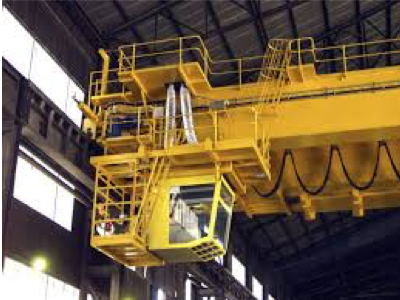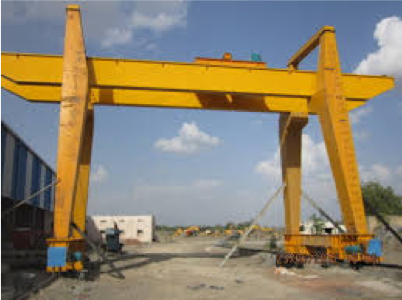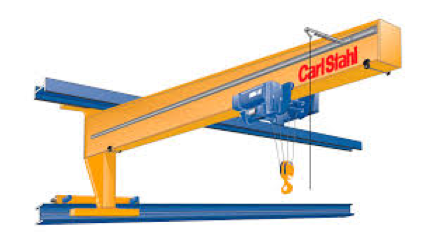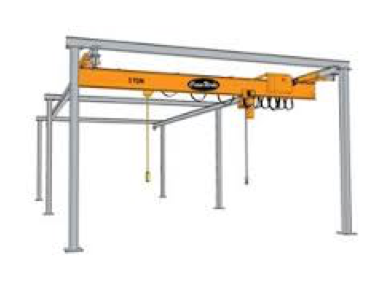Picture Dictionary of Overhead Crane Terminology
The primary components of a Double Girder, Top Running, Overhead Bridge Crane
OSHA 1910.179(a)(1)
3 motions of an overhead electric bridge crane
A "crane"is a machine for lifting and lowering a load and moving it horizontally, with the hoisting mechanism an integral part of the machine. Cranes whether fixed or mobile are driven manually or by power.
Cab operated bridge crane
OSHA 1910.179(a)(3)
A "cab-operated crane" is a crane controlled by an operator in a cab located on the bridge or trolley.
Double leg, Gantry Crane
OSHA 1910.179(a)(4)
"Cantilever gantry crane" means a gantry or semigantry crane in which the bridge girders or trusses extend transversely beyond the crane runway on one or both sides.
OSHA 1910.179(a)(5)
"Floor-operated crane" means a crane which is pendant or nonconductive rope controlled by an operator on the floor or an independent platform.
Double leg, Gantry Crane
OSHA 1910.179(a)(6)
"Gantry crane" means a crane similar to an overhead crane except that the bridge for carrying the trolley or trolleys is rigidly supported on two or more legs running on fixed rails or other runway.
OSHA 1910.179(a)(7)
"Hot metal handling crane" means an overhead crane used for transporting or pouring molten material.
OSHA 1910.179(a)(8)
"Overhead crane" means a crane with a movable bridge carrying a movable or fixed hoisting mechanism and traveling on an overhead fixed runway structure.
OSHA 1910.179(a)(9)
"Power-operated crane" means a crane whose mechanism is driven by electric, air, hydraulic, or internal combustion means.
OSHA 1910.179(a)(10)
A "pulpit-operated crane" is a crane operated from a fixed operator station not attached to the crane.
OSHA 1910.179(a)(11)
A "remote-operated crane" is a crane controlled by an operator not in a pulpit or in the cab attached to the crane, by any method other than pendant or rope control.
OSHA 1910.179(a)(12)
Single leg, Gantry Crane
A "semigantry crane" is a gantry crane with one end of the bridge rigidly supported on one or more legs that run on a fixed rail or runway, the other end of the bridge being supported by a truck running on an elevated rail or runway.
OSHA 1910.179(a)(13)
"Storage bridge crane" means a gantry type crane of long span usually used for bulk storage of material; the bridge girders or trusses are rigidly or nonrigidly supported on one or more legs. It may have one or more fixed or hinged cantilever ends.
OSHA 1910.179(a)(14)
Wall mounted crane
"Wall crane" means a crane having a jib with or without trolley and supported from a side wall or line of columns of a building. It is a traveling type and operates on a runway attached to the side wall or columns.
OSHA
"Appointed" means assigned specific responsibilities by the employer or the employer's representative.
OSHA 1910.179(a)(16)
"ANSI" means the American National Standards Institute.
OSHA 1910.179(a)(17)
An "auxiliary hoist" is a supplemental hoisting unit of lighter capacity and usually higher speed than provided for the main hoist.
Electrically operated crane brake
OSHA 1910.179(a)(18)
A "brake" is a device used for retarding or stopping motion by friction or power means.
OSHA 1910.179(a)(19)
A "drag brake" is a brake which provides retarding force without external control.
OSHA 1910.179(a)(20)
A "holding brake" is a brake that automatically prevents motion when power is off.
OSHA 1910.179(a)(21)
"Bridge" means that part of a crane consisting of girders, trucks, end ties, footwalks, and drive mechanism which carries the trolley or trolleys.
OSHA 1910.179(a)(22)
"Bridge travel" means the crane movement in a direction parallel to the crane runway.
OSHA 1910.179(a)(23)
Crane bumpers with extensions.
A "bumper" [buffer] is an energy absorbing device for reducing impact when a moving crane or trolley reaches the end of its permitted travel; or when two moving cranes or trolleys come in contact.
OSHA 1910.179(a)(24)
Crane cab
The "cab" is the operator's compartment on a crane.
OSHA 1910.179(a)(25)
"Clearance" means the distance from any part of the crane to a point of the nearest obstruction.
Critical crane dimensions
OSHA 1910.179(a)(26)
Bridge girder electrical bar and collectors
"Collectors current" are contacting devices for collecting current from runway or bridge conductors.
OSHA 1910.179(a)(27)
Crane electrical festooning
"Conductors, bridge" are the electrical conductors located along the bridge structure of a crane to provide power to the trolley.
OSHA 1910.179(a)(28)
"Conductors, runway" [main] are the electrical conductors located along a crane runway to provide power to the crane.
OSHA 1910.179(a)(29)
The "control braking means" is a method of controlling crane motor speed when in an overhauling condition.
OSHA 1910.179(a)(30)
"Countertorque" means a method of control by which the power to the motor is reversed to develop torque in the opposite direction.
OSHA 1910.179(a)(31)
"Dynamic" means a method of controlling crane motor speeds when in the overhauling condition to provide a retarding force.
OSHA 1910.179(a)(32)
"Regenerative" means a form of dynamic braking in which the electrical energy generated is fed back into the power system.
OSHA 1910.179(a)(33)1910.179(a)(33)
"Mechanical" means a method of control by friction.
OSHA 1910.179(a)(34)
"Controller, spring return" means a controller which when released will return automatically to a neutral position.
OSHA 1910.179(a)(35)
"Designated" means selected or assigned by the employer or the employer's representative as being qualified to perform specific duties.
OSHA 1910.179(a)(36)
A "drift point" means a point on a travel motion controller which releases the brake while the motor is not energized. This allows for coasting before the brake is set.
OSHA 1910.179(a)(37)
The "drum" is the cylindrical member around which the ropes are wound for raising or lowering the load.
OSHA 1910.179(a)(38)
An "equalizer" is a device which compensates for unequal length or stretch of a rope.
OSHA 1910.179(a)(39)
"Exposed" means capable of being contacted inadvertently. Applied to hazardous objects not adequately guarded or isolated.
OSHA 1910.179(a)(40)
"Fail-safe" means a provision designed to automatically stop or safely control any motion in which a malfunction occurs.
OSHA 1910.179(a)(41)
"Footwalk" means the walkway with handrail, attached to the bridge or trolley for access purposes.
OSHA 1910.179(a)(42)
Package hoist
A "hoist"is an apparatus which may be a part of a crane, exerting a force for lifting or lowering.
OSHA 1910.179(a)(43)
"Hoist chain" means the load bearing chain in a hoist.
OSHA 1910.179(a)(44)
"Hoist motion" means that motion of a crane which raises and lowers a load.
OSHA 1910.179(a)(45)
"Load" means the total superimposed weight on the load block or hook.
OSHA 1910.179(a)(46)
Hook and lower block assembly
The "load block" is the assembly of hook or shackle, swivel, bearing, sheaves, pins, and frame suspended by the hoisting rope.
OSHA 1910.179(a)(47)
Crane magnet
"Magnet" means an electromagnetic device carried on a crane hook to pick up loads magnetically.
OSHA 1910.179(a)(48)
"Main hoist" means the hoist mechanism provided for lifting the maximum rated load.
OSHA 1910.179(a)(49)
A "man trolley" is a trolley having an operator's cab attached thereto.
OSHA 1910.179(a)(50)
"Rated load" means the maximum load for which a crane or individual hoist is designed and built by the manufacturer and shown on the equipment nameplate(s).
OSHA 1910.179(a)(51)
"Rope" refers to wire rope, unless otherwise specified.
OSHA 1910.179(a)(52)
"Running sheave" means a sheave which rotates as the load block is raised or lowered.
OSHA 1910.179(a)(53)
Crane runway and runway supports (gray).
"Runway" means an assembly of rails, beams, girders, brackets, and framework on which the crane or trolley travels.
OSHA 1910.179(a)(54)
Side-pull
"Side pull" means that portion of the hoist pull acting horizontally when the hoist lines are not operated vertically.
OSHA 1910.179(a)(55)
Crane span “S”
"Span" means the horizontal distance center to center of runway rails.
OSHA 1910.179(a)(56)
"Standby crane" means a crane which is not in regular service but which is used occasionally or intermittently as required.
OSHA 1910.179(a)(57)
Crane runway wheel
A "stop" is a device to limit travel of a trolley or crane bridge. This device normally is attached to a fixed structure and normally does not have energy absorbing ability.
OSHA 1910.179(a)(58)
A "switch" is a device for making, breaking, or for changing the connections in an electric circuit.
OSHA 1910.179(a)(59)
An "emergency stop switch" is a manually or automatically operated electric switch to cut off electric power independently of the regular operating controls.
OSHA 1910.179(a)(60)
A "limit switch" is a switch which is operated by some part or motion of a power-driven machine or equipment to alter the electric circuit associated with the machine or equipment.
OSHA 1910.179(a)(61)
A "main switch" is a switch controlling the entire power supply to the crane.
OSHA 1910.179(a)(62)
A "master switch" is a switch which dominates the operation of contactors, relays, or other remotely operated devices.
OSHA 1910.179(a)(63)
Hoist with underhung trolley
The "trolley" is the unit which travels on the bridge rails and carries the hoisting mechanism.
OSHA 1910.179(a)(64)
Crane trolley travel is a lateral motion
"Trolley travel" means the trolley movement at right angles to the crane runway.
OSHA 1910.179(a)(65)
Bridge crane end-truck of simply “truck”
"Truck" means the unit consisting of a frame, wheels, bearings, and axles which supports the bridge girders or trolleys.























